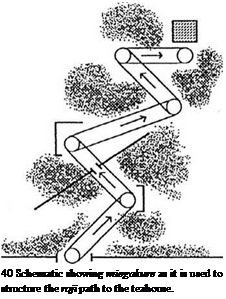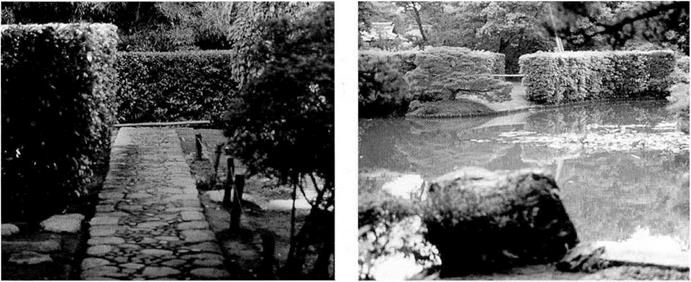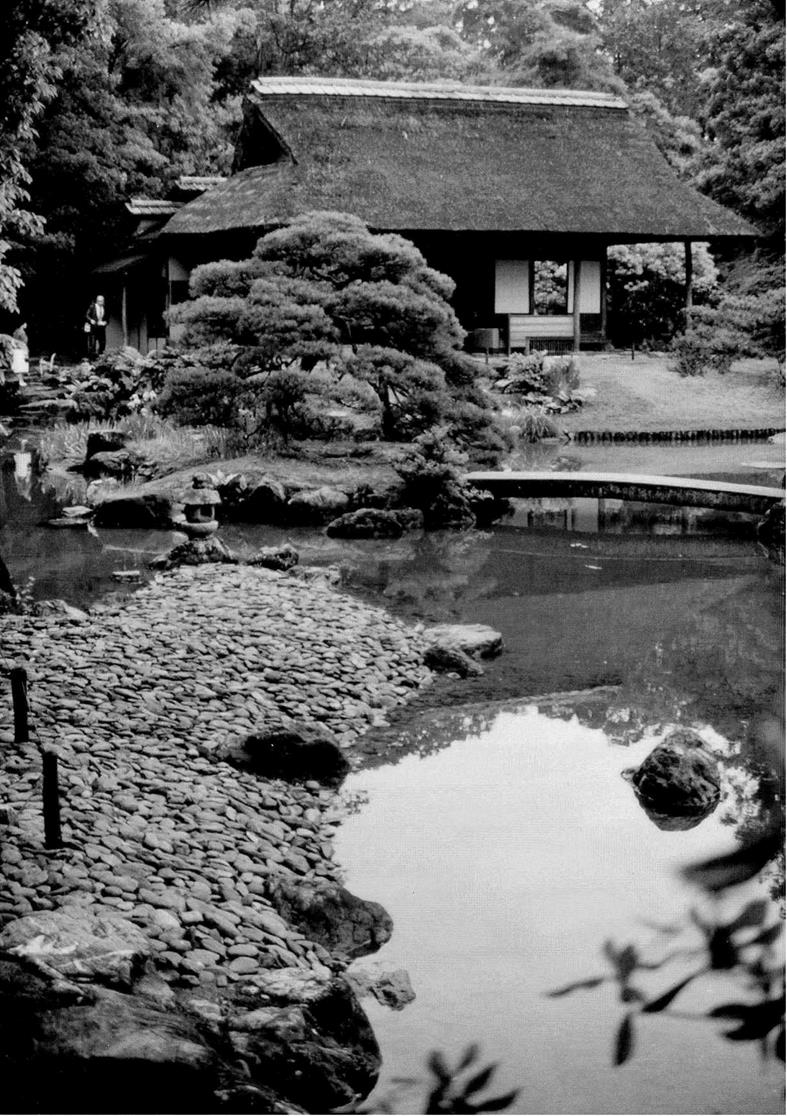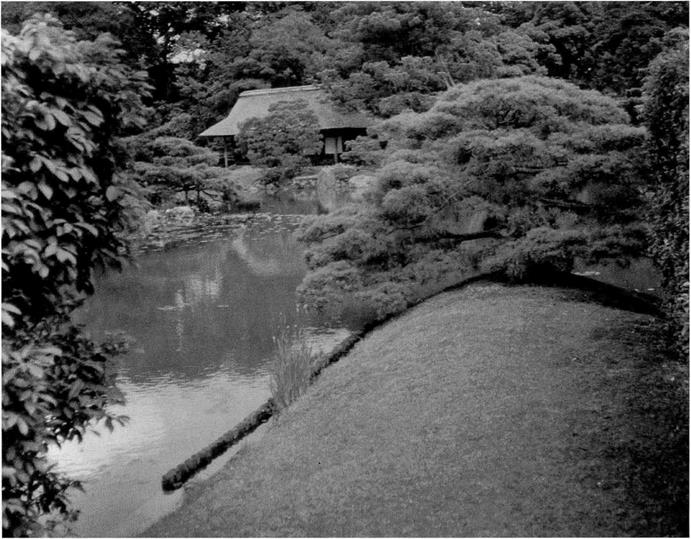The act of stepping down from the veranda and walking in the garden begins with the roji. The roji in its early form consisted merely of a walkway leading to the tearoom, and thus could hardly be called a garden (Figures 38.1-38.2). By definition, the roji (“dewy ground”) is a path, not a garden, which brings out its essential quality, of being “walked.”
As the presence of a ritual washbasin—where guests cleanse their hands, mouth, and, symbolically, their spirit—would suggest, the roji played an important role in preparing the minds of those who were about to participate in a tea gathering, or chanoyu, and was a point of transition from the mundane world to the realm of tea.
I 62
The spirit of chanoyu was described by sixteenth-century tea master Sen no Rikyu with the phrase “ichi go ichi e” (“one life, one meeting”), which suggests that every human encounter is a singular occasion. From the beginning, any elements that might hinder the preparation of the mind were eliminated from the roji.
The prototype of the thatched-hut soan teahouse and accompanying roji is that of “a mountain locale set within a city.” The following verse by twelfth-century ascetic poet – monk Saigyo can be said to describe the atmosphere of the ideal roji.
Leaves of the kashi trees,
Even before they were tinged Are all scattered
Along the path to the mountain monastery Lone and desolate.2
The solitary, austere quality of the image of a “mountain path” was meant to underscore the fact that the world of chanoyu was separate from that of society. It was Rikyu’s belief that from a place where there is “nothing,” that which is true and genuine manifests itself.
When a roji is set within a city, the creation of a mountain path is of course artificial, but still the roji is required to express the essence of a mountain locale. This suggests that the roji has two fundamental aspects: functionally, it provides a path for walking, while thematically it expresses “the natural landscape” as specified in Sakuteikis first
 |
 |
principle, of “recalling your memories of how nature presented itself for each feature.” It is important to note here that the roji possessed both these aspects from the time of its first appearance.
As the art of tea flourished, the roji was progressively articulated and developed (Figure 39). It was equipped with various types of facilities for the host to welcome his guests, and likewise for the guests to acknowledge the host’s hospitality. It was divided into complex two-and three-section gardens, called double-and triple-roji. Indeed, the process of growth did not stop at this point, for the roji eventually led to the development of the stroll garden.
Miegakure is a design concept fundamental to roji garden making—used for configuring the path that leads from the roji entrance and the outer roji through the central gate (nakamon) to the inner roji and up to the nijiriguchi (low, sliding-door entrance to the tearoom; Figure 40).
The standard tea garden composition involves a double roji with outer and inner sections that are divided by a central gate. Typical features of the outer roji start with an entrance gate, which marks the threshold between the roji and the outer world, and also include a yoritsuki (changing room for removing outer garments), a koshikake machiai (covered bench where guests wait to be called to the teahouse), a setchin (lavatory), wooden lanterns, and a chiriana (small “dust pit” originally used to collect fallen leaves and other debris; now symbolic of leaving behind the cares of this world before entering the tearoom).
The central gate that forms the boundary between the outer and inner roji varies from rudimentary shiorido gates made of branches to the highly refined baikenmon (bamboo lattice doors between stripped cypress pillars supporting a roof of cedar bark). The gate is flanked by short spans of fencing, usually bamboo trellises, on either side. The inner roji contains a koshikake machiai, a suna setchin (lavatory spread with river sand and stones), another chiriana, stone lanterns, and a tsukubai (a stone basin for ritual rinsing of the hands and mouth). Spans of stone pavements and stepping-stones lead from the garden entrance to the nijiriguchi sliding door to the teahouse.
The defining characteristic of roji composition is that it does not allow for an open view of the garden in its entirety. Using both tangible and intangible barriers, isolated scenes are alternately displayed and concealed along the path. In this way, space design by miegakure focuses the viewer’s attention, incrementally revealing the substantial profundity of the entire roji. Miegakure here creates settings with intangible barriers to contain the expected, even ritualized, movements of the guests as they visit the facilities arranged within the very confined overall space of the roji, while yet establishing continuity with the next movement in the sequence. Thus, the vital integrating factor is precisely the guest’s own movement through the garden (Figures 41.1-41.4).
Miegakure as found in the roji is an advanced development of the multifaceted, continuous linking of homoge-
|
|
|
|
||
|

neous points that originated in the Zen temple north garden. It is also part of the developmental process that led to the linking of qualitatively distinct spaces in the stroll garden, which is of course also based on the principle of kinetic, ambulatory viewing.
Rikyu’s own roji in Sakai was on the coast with a beautiful vista of the sea, but the view was intentionally obscured by trees. Only near the teahouse entrance, in front of the water-basin, did he provide a small opening in the hedge to give a glimpse of the sea. This arrangement corresponds closely to a garden feature described in Sakuteiki: “ [A]rrange the hills so that the full view of the sea is not seen. Instead, the sea should be made visible only through the small opening of the hills.”3 Here again we can see that miegakure evolved from a foundation in the view-obstructing methods used in gardens of Heian – period palace architecture.
As the following didactic poem by Sen no Rikyu suggests, great importance was placed on ensuring that tea ceremony participants’ minds were not distracted, but rather focused, by the roji.
Since the Dewy Path
Is a way that lies outside
This most impure world
Shall we not on entering it
Cleanse our hearts from earthly mire?4
The roji tea garden was not intended for enjoyment. For Rikyu, it was, like the teahouse itself, a space designed for those who considered the way of tea to be synonymous with Zen practice, and its ultimate goal was to show that “Zen and tea have the same flavor.” In this sense the roji is distinguished in its spiritual foundations from the later stroll garden, which developed from the more pleasure-oriented branch of tea known as suki.
It is only after many years of practice that you will
grasp in its details the fact that everything, from the hundred thousand ways of displaying utensils to the straw-thatched wabi tearoom, is governed by the measurements, based on yin and yang, applied in using the daisu [utensil stand]. Moreover, since the fundamental intent of wabi [beauty amid utter simplicity] lies in manifesting the pure, undefiled Buddha-world, once host and guest have entered the roji and the thatched hut, they sweep away the dust and rubbish (of worldly concern) and engage in an encounter with mind open and entire; hence, there is no need to speak insistently of measurements and sun and shaku, or of formal rules of tea procedure. Chanoyu is just a matter of building a fire, boiling water, and drinking tea. There should be nothing else. Here the Buddha-mind emerges to reveal itself.5
These words, recorded by a close disciple, show the contradiction inherent in Rikyu’s own appreciation of the role of formality, but this is a contradiction that runs right through the way of tea itself.
Originally, drinking tea was a perfectly ordinary, everyday activity; it was a medium for people to meet and chat briefly, and as such included both a social aspect and an aspect of simple enjoyment in its very foundations. Rikyu focused on and rigorously pursued an ideal form of social interaction—direct heart-to-heart reciprocation, through tea. In this pursuit he came to the conclusion that the small tearoom (кота) and the roji were essential to achieving the necessary attentiveness, and that the chanoyu environment should be completed by the proper combination and placement of utensils. However, there were others who focused on tea not as a Zen practice or a pure form of communication, but as a simple form of amusement.
Soeki [Rikyu] was the first to construct a tearoom of the virtually minimum size of one-and-a-half mats.
Although unusual for its time, it was of little use to the ordinary person. It is interesting that Soeki, being a meijin [master], could freely transform mountains into valleys, change west to east, and break the rules of chanoyu. But if an ordinary person were to imitate him, there would be no chanoyu,6
Here Sen no Rikyu’s Zen practice is turned into a mere curiosity. Following Rikyu’s death, this relatively superficial approach triumphed, and the small кота tearoom was dismissed as being too “uncomfortable for the guests.” The way of tea came to be viewed as essentially a pleasurable pastime. Not only was the small tearoom rejected, but a kusari no та (“connecting room”) was constructed as a place to display utensils, and the concept of “a mountain locale set within a city” was transformed—valued not as a spiritual retreat, but as a pleasant escape from everyday life.
This way of thinking eventually evolved into the spatial formalism known as sukiya-zukuri. Suki, meaning con – noisseurship, initially described a conception of beauty that was unorthodox, but came to refer to the enjoyment of a subtly elegant form of tea ceremony, while sukiya, as used in this text, came to refer to the hiroma (“large [tea] rooms”) in which these ceremonies were performed. The principal factor guiding the design of sukiya was the anticipated patterns of people’s physical movements and emotional responses within the space.
This architectural approach can perhaps best be expressed as an amalgamation of the spirit of chanoyu and the sukiya spatial format. The results of adding the element of heightened attention, as cultivated in the walk through the roji, to the condensed shoin garden were, first, the linking of qualitatively different spaces—the shoin, sukiya, and sdan—and, ultimately, the blossoming of the Edo-period stroll garden, or pleasure garden.
Insight into the social climate that gave rise to the development of sukiya-zukuri in the early Edo period is critical to an understanding of the changes in composition of buildings and gardens that occurred with the great transformation of the way of tea after Rikyu’s death.
Once the Tokugawa regime had been established, an immensely stable social system divided along rigid class lines, and the peace achieved by a policy of national seclusion gave rise to a varied, vibrant urban society. Lifestyle and aesthetic taste generally fell into one of three discrete cultural realms: the aristocratic culture centered around the court, buke warrior culture revolving around the shogu – nate, and the affluent culture of the urban merchant classes. This is the context in which distinct garden types developed based on the differing lifestyles, emotions, and aesthetics of these three cultural realms.
New aesthetic ideals which arose in this time—including iki (an urbane chic with undertones of sensuality), okashimi (humor; also, amused recognition that something is ludicrous but inevitable), and furyu (used in reference to both the ostentatious beauty seen in popular arts, and the more tasteful beauty of such elegant pastimes as landscape gardening, flower arrangement, and tea ceremony)—were pregnant with the contradictions of everyday reality. Ironically, the prospering urban merchant class, known as chonin, fostered a vibrant popular culture, despite having been relegated to the bottom of the social scale.
These divergent developments in changing traditions evoked the criticisms of Rikyu mentioned above. Rikyu’s way of tea as Zen practice was rejected, and it seemed that the aesthetic ideals that sought beauty in restraint—wabi (utter simplicity, or the appreciation of a higher beauty amid apparent lack of beauty), and sabi (appreciation of the patina of use and age)—had waned. But they had not disappeared altogether, for in some quarters Rikyu was apotheosized, and the tea ceremony was ritualized and revered as the ultimate aesthetic activity.





